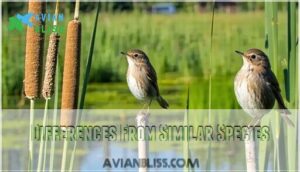This site is supported by our readers. We may earn a commission, at no cost to you, if you purchase through links.

You’ll spot this distinctive bird by its thick, blunt bill that develops a bold black band during breeding season, giving it that "pied" appearance.
Unlike surface-feeding ducks, these aquatic acrobats dive underwater to hunt crayfish, small fish, and insects in shallow marshes and ponds.
Their legs sit far back on their bodies, creating powerful underwater propulsion with lobed toes that work like miniature flippers.
When threatened, they’ve earned the nickname "hell-diver" for their uncanny ability to vanish beneath the surface by controlling their buoyancy—a disappearing act that’s both practical and mesmerizing to witness in their freshwater habitats.
Table Of Contents
- Key Takeaways
- Pied-billed Grebe Identification
- Habitat and Range
- Behavior and Life Cycle
- Adaptations and Unique Traits
- Conservation and Interesting Facts
- Frequently Asked Questions (FAQs)
- What is special about a pied-billed grebe?
- Is a pied-billed grebe a duck?
- Is the Pied-Billed Grebe endangered?
- Can pied-billed grebes walk on land?
- What are the pied-billed grebes natural predators?
- How deep can they dive?
- What are their breeding habits?
- Do pied-billed grebes migrate?
- How do they care for their young?
- How long do pied-billed grebes live?
- Conclusion
Key Takeaways
- You’ll spot pied billed grebes by their chunky, robin-sized bodies and distinctive thick bills that develop bold black bands during breeding season, making them easy to identify among other waterfowl.
- You’re watching nature’s submarine masters when you see these birds vanish underwater—they control their buoyancy by trapping air in their feathers and use lobed toes like miniature flippers for powerful propulsion.
- You’ll find these diving specialists in shallow freshwater marshes and ponds across North America, where they hunt crayfish, small fish, and insects during 20-30 second underwater dives.
- You’re observing remarkable parents when you see grebe chicks riding piggyback on their adults’ backs—both parents share incubation duties and provide taxi service while hunting for their striped young.
Pied-billed Grebe Identification
You’ll recognize a Pied-billed Grebe by its compact, chunky body and distinctively large, blocky head that sits on a slender neck.
The bird’s thick, blunt bill becomes particularly striking during breeding season when it develops a bold black band around its pale base, making the breeding season a notable time for observation.
Size and Shape
You’ll immediately recognize a Pied-billed Grebe by its compact body that’s surprisingly chunky for a water bird.
Think robin-meets-crow proportions—measuring 12-15 inches with a distinctive blocky head that seems oversized for its slender neck.
The bird’s short, thick bill and virtually nonexistent tail create an unmistakable silhouette, while its 18-24 inch wing span supports efficient underwater propulsion, utilizing its compact body for efficient movement.
Color Pattern
Beyond its compact body, the pied billed grebe showcases distinct seasonal color patterns that make identification straightforward.
You’ll notice dramatic changes as molt cycles shift their appearance throughout the year.
Key color pattern features:
- Breeding plumage transforms brown-gray winter feathers into richer, darker tones with distinctive bill patterns
- Summer colors include a prominent black band encircling their thick, silver-white bill
- Feather texture remains consistently brownish above with pale bellies year-round
Key Identification Features
When identifying a pied billed grebe, focus on its distinctive bill shape and head pattern combination.
The thick, blunt beak turns silver-white with a bold black band during breeding season.
Note the large, blocky head contrasting with the compact body size.
This chunky build and virtually absent tail create an unmistakable silhouette that separates it from other waterfowl across North America.
Observing the bird’s overall size and shape requires understanding of basic bird identification characteristics to facilitate accurate classification.
Differences From Similar Species
Unlike American Coots with their white bills and lobed toes, you’ll spot Pied-billed Grebes by their chunky, chicken-like bills that develop distinctive black bands during breeding season.
These grebe bird facts help distinguish them: they’re smaller than coots but larger than most ducks, with compact bodies and virtually no tail.
Their bill shape and feather patterns make species comparison straightforward once you know what to look for.
Identification Tips
When spotting these compact water birds, focus on three key features that make piedbilled grebe identification straightforward. Their distinctive bill shape and beak color changes seasonally, while their body size remains consistent year-round.
Understanding grebe behavior patterns helps confirm your bird species identification.
- Bill Shape and Color: Watch for the thick, blunt bill that turns silver with a black band during breeding season – this distinctive beak color transformation is unique among grebe bird facts.
- Head Pattern and Feather Color: Notice the large, blocky head relative to the compact body, with brownish-gray winter plumage shifting to brighter breeding colors.
- Behavioral Cues: Look for their signature "sink and disappear" diving technique rather than flying when disturbed – classic grebe behavior that separates them from ducks.
Habitat and Range
You’ll find pied-billed grebes on quiet freshwater wetlands across North America, from shallow marshes to tree-lined ponds with plenty of emergent vegetation.
They prefer the "Goldilocks zone" of wetland habitat – not too open, not too dense – where cattails and sedges create perfect cover for their floating nests, making it an ideal spot for them to thrive in their preferred environment with emergent vegetation.
Preferred Habitats
Pied-billed grebes thrive in shallow freshwater habitats where emergent aquatic plants create perfect hunting grounds.
You’ll find these aquatic birds in wetland ecosystems featuring cattails and bulrushes, particularly in marsh environments with water depths of 1.5-5 feet.
Lake shores with dense vegetation offer ideal grebe habitat, supporting both nesting and foraging activities in these productive marsh habitats.
The creation of wetland bird homes is essential for maintaining healthy grebe populations in their native habitats.
Geographic Distribution
Across North America’s vast wetlands, Podilymbus podiceps claims an impressive geographic range from coastal Alaska to maritime Canada, extending throughout most continental United States.
You’ll find breeding grounds concentrated in the Dakota "waterfowl factories" and Canadian prairies, while year-round populations thrive in southeastern and western regions.
This adaptable species inhabits freshwater marshes and lakes wherever suitable habitat exists, from Florida’s Everglades to California’s Central Valley, making it North America’s most widespread grebe.
The species’ survival depends on preserving its natural habitat areas.
Seasonal Movements
Seasonal movements follow predictable patterns that mirror nature’s rhythms.
You’ll find these grebes moving south when ice locks their northern breeding waters, typically from late fall through winter.
They’ll seek ice-free habitats along coasts and southern freshwater bodies during harsh months.
Spring triggers their return migration to familiar breeding territories, where habitat shifts from wintering areas to marshy nesting sites occur seamlessly.
Best Locations for Observation
Wildlife management areas like Tonawanda and Salmon River Mouth offer prime Piedbilled Grebe viewing opportunities.
You’ll find these diving specialists in freshwater lakes, wetland sites, and coastal areas during migration.
Early morning birding tours at marshlands provide excellent wildlife photography chances, while river mouths attract wintering flocks.
Supporting grebe conservation starts with visiting these accessible locations.
Behavior and Life Cycle
You’ll witness fascinating behavior patterns as pied-billed grebes navigate their aquatic world with remarkable skill and purpose.
Watch these aquatic masters vanish underwater like feathered submarines, controlling their own buoyancy with scientific precision
From their unique "taxi service" for chicks to their secretive nesting habits, these small diving birds demonstrate complex social behaviors that reveal their remarkable adaptation to wetland life, showcasing their ability to thrive in their environment with remarkable skill.
Feeding Habits and Diet
You’ll find grebe diet composition surprisingly diverse, targeting everything from crayfish to small fish through specialized foraging strategies.
These diving birds excel at prey capture during 20-30 second underwater hunts, using their chunky bills to crush shells and capture aquatic insects.
Their feeding behavior adapts seasonally – more insects in spring, fish and amphibians later, which helps them thrive across varied aquatic ecosystems throughout their range.
The grebe’s unique adaptations, such as feather consumption habits, play a vital role in their ability to digest hard prey parts, showcasing their flexible nutrient intake and specialized foraging strategies.
Nesting and Breeding
Pied-billed grebes begin their breeding season in mid-May, with both sexes constructing floating nests from vegetation within 3-7 days.
These Podicipedidae members build roughly circular platforms anchored near emergent plants in shallow water.
Females lay 4-7 smooth, elliptical eggs that start almost white but become nest-stained. Egg incubation lasts 23-27 days, with males sharing duties until hatching begins.
Parental Care and Chicks
Once nesting wraps up, you’ll witness remarkable grebe parenting in action.
Both adults share brood care duties, with chicks riding piggyback-style on their parents’ backs like tiny feathered passengers.
These striped baby grebes receive constant parental feeding through underwater hunting expeditions.
During chick development, adults demonstrate impressive multitasking, diving for fish while keeping their precious cargo secure aboard their backs.
The parental care exhibited by grebes is similar to bluebird parental care strategies, where both parents work together to raise their young, showcasing impressive cooperation and dedication to their offspring.
Migration Patterns
Migration represents nature’s most remarkable annual journey for these diving birds.
You’ll witness pied-billed grebes following established flyways from September through November, triggered by freezing temperatures.
Their seasonal moves span 500-1,500 miles along major migration routes, utilizing Mississippi River Valley and Great Lakes stopovers.
Spring returns occur March-May, with breeding sites and wintering grounds showing remarkable site fidelity among migratory birds.
Adaptations and Unique Traits
You’ll discover that pied-billed grebes possess remarkable adaptations that make them masters of aquatic life.
Their specialized features allow them to thrive in wetland environments where other birds struggle to survive.
Feet and Lobed Toes
Water propulsion becomes effortless when you observe these remarkable feet.
Each toe features distinct lobes that expand during the power stroke, creating paddle-like surfaces for maximum thrust.
Unlike typical webbed feet found in ducks, Pied-billed Grebes possess individually lobed toes that collapse during recovery strokes, reducing drag.
This specialized toe structure makes them incredibly efficient swimmers, positioning their feet far back on their bodies for ideal foot propulsion underwater.
The unique shape of their feet is related to advanced toe prop systems, which is a key feature of their swimming ability, allowing for maximum thrust, and is an example of efficient swimmers, with specialized toe structure.
Diving and Propulsion
Looking beyond their distinctive feet, grebes showcase remarkable diving efficiency through specialized propulsion methods.
Their legs positioned far back generate powerful thrust with rapid alternating strokes reaching 2.5 strokes per second.
This swimming efficiency allows these diving birds to reach dive depths of 1.5-2 meters while maintaining dive speed for underwater pursuits lasting 15-30 seconds.
Buoyancy and Water-trapping Ability
Pied-billed grebes control their Water Density like submarine captains adjusting ballast tanks.
These aquatic acrobats disappear like magic, controlling their underwater ballet with submarine precision
Their Feather Coats trap air pockets that counteract Buoyant Forces, letting them fine-tune their Dive Mechanics.
Unlike other water bird species, these diving birds manipulate Surface Tension expertly.
The Podicipedidae family’s buoyancy mastery surpasses most bird species list entries.
- Air pocket compression – You’ll see them squeeze trapped air from feathers to sink deeper
- Feather angle adjustment – They position plumage to control water penetration levels precisely
- Gradual submersion technique – Watch them slowly disappear without creating surface ripples
- Variable buoyancy control – They can hover at different water depths like aquatic helicopters
- Instant surface breaks – Quick air release lets them pop up unexpectedly during grebe nesting habits
Camouflage and Defense Tactics
When threatened, you’ll notice these birds employ remarkable stealth behavior and concealment strategies.
They’ll gradually sink beneath the surface for underwater hiding, leaving only their bills exposed like tiny periscopes.
This threat evasion technique, combined with their natural camouflage among emergent vegetation, makes them masters of disappearing acts during grebe nesting habits observations.
The grebe’s ability to use cryptic coloration methods enhances their overall defense tactics and survival rates in their natural habitats.
Conservation and Interesting Facts
You’ll find the pied-billed grebe maintains stable populations across most of its range, though habitat loss from wetland drainage poses ongoing challenges.
These remarkable birds produce distinctive cow-like calls during breeding season and can actually control their buoyancy by trapping air in their feathers—a trick that makes them seem to vanish underwater when threatened, utilizing their unique ability to trap air.
Conservation Status and Threats
While these remarkable diving birds appear stable globally, you’ll find they’re fighting an uphill battle against modern threats.
Their conservation status reveals a troubling pattern of regional decline despite overall population stability.
Here’s what’s putting pressure on grebe populations:
- Habitat Loss through wetland drainage eliminates 90% of original breeding sites
- Climate Change alters water levels, disrupting nesting success rates substantially
- Pollution Effects from pesticides contaminate up to 35% of surveyed wetlands
- Human Impact from recreation causes nest abandonment during critical periods
- Extinction Risk varies by region, with several states listing them as endangered species
Population Trends
Over 500,000 Pied-billed Grebes currently thrive across North America, with grebe population trends showing remarkable stability despite habitat loss pressures.
Breeding patterns remain consistent in managed refuges, while migration routes adapt to climate shifts.
Population dynamics reveal regional variations – northern territories stay steady, but southern breeding sites face 7-10% declines.
Conservation efforts focus on wetland restoration to counter development impacts affecting Podilymbus podiceps populations, which is crucial for maintaining population stability.
Notable Vocalizations and Calls
During breeding season, you’ll hear Podilymbus podiceps deliver their signature "cow-cow-cow-cowp-cowp" call patterns across wetlands.
These bird calls start loud and rhythmic, then slow dramatically – creating distinctive sound waves that travel over a kilometer.
Paired grebes occasionally perform coordinated duets, showcasing advanced communication styles.
Their cuckoo-like bird songs help identify this grebe species among marsh vegetation, demonstrating remarkable avian characteristics and sophisticated bird behavior.
Cultural Significance and Fun Facts
These small diving birds have quietly paddled through Native American folklore for centuries, where Grebe Mythology often portrays Podilymbus podiceps as symbols of persistence and adaptability.
Their "sink and hide" behavior has inspired countless Folklore Stories about resilience.
- Grebe Legends tell of warriors who learned stealth by watching these masters of camouflage disappear beneath water’s surface
- Bird Symbolism connects grebes to emotional depth and the ability to navigate life’s murky waters with grace
- Cultural Icons in ornithology studies, these birds represent the perfect balance between visibility and mystery in bird watching tips
Understanding bird intelligence levels can provide insights into their unique behaviors and abilities.
Frequently Asked Questions (FAQs)
What is special about a pied-billed grebe?
You’ll discover this diving duck‘s magic lies in its vanishing act—it sinks like a submarine when threatened, plus those lobed toes make it swim circles around other waterfowl.
Is a pied-billed grebe a duck?
No, you’re not looking at a duck.
Pied-billed grebes belong to their own family called Podicipedidae, making them distinct from ducks.
They’re diving specialists with lobed toes instead of webbed feet like ducks have.
Is the Pied-Billed Grebe endangered?
Worried about these chunky swimming birds disappearing? You’ll be relieved to know pied-billed grebes aren’t endangered.
They’re actually widespread across North America, thriving in marshes and lakes from Canada to South America with stable populations.
Can pied-billed grebes walk on land?
You can’t really expect these birds to strut around like chickens.
Their feet sit way back on their bodies, making land walking awkward and clumsy.
They’re built for water, not pavement.
What are the pied-billed grebes natural predators?
You’ll find their natural predators include raccoons, minks, and large fish targeting eggs and chicks.
Adult grebes face threats from raptors like hawks, plus snapping turtles and northern pike in water.
How deep can they dive?
You’ll find pied-billed grebes diving to depths of about 20 feet or less.
They typically stay underwater for 20-30 seconds per hunting dive, using their compact bodies to chase fish and aquatic insects in shallow waters.
What are their breeding habits?
You’ll find these birds start breeding in mid-May when both sexes build floating nests from vegetation in shallow marshes.
They’ll lay 4-7 white eggs, incubate them for 23 days, and adorable striped chicks ride on their parents’ backs.
Do pied-billed grebes migrate?
Yes, you’ll see these birds migrate seasonally. They winter south of the ice line in freshwater or saltwater habitats, moving from northern breeding areas to warmer southern regions and coasts.
How do they care for their young?
Pied-billed grebe parents share incubation duties for 23 days, then carry their striped chicks on their backs.
You’ll see adults diving for insects and small fish to feed the young, who ride along like tiny passengers on a living boat.
How long do pied-billed grebes live?
Most surprisingly, you’ll discover these hardy birds can live up to 10-12 years in the wild.
Their lifespan varies substantially based on habitat quality, predation pressure, and environmental conditions you’ll encounter in their wetland homes, which can significantly impact their survival and is closely related to wetland homes.
Conclusion
Think of a master magician who vanishes completely underwater—that’s the pied billed grebe’s greatest trick.
You’ve discovered North America’s most adaptable diving waterbird, a feathered submarine that’s mastered freshwater living through millions of years of evolution.
Whether you’re watching one disappear beneath glassy pond surfaces or spotting that distinctive black-banded bill during breeding season, you’re witnessing remarkable aquatic engineering.
Next time you visit marshlands or quiet lakes, keep your eyes peeled for these hell-divers performing their vanishing acts.















